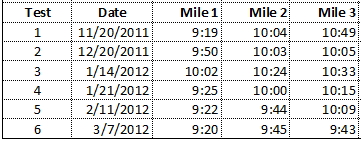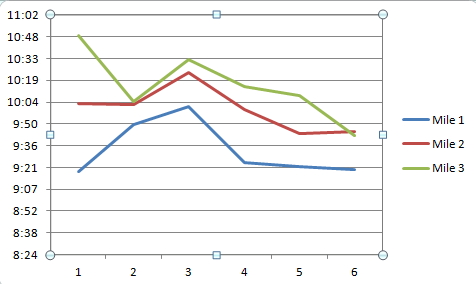Heart Rate Training
Late last year, I wrote a post titled Change of (Training) Plans. I had just come off a personal best in a half marathon, but I didn’t feel my personal best. I was over training and worn out. Based on some articles from the Natural Running Center‘s Dr. Mark Cucuzzella and veteran endurance coach Dr. Phil Maffetone, I changed my training method leading into this spring racing season.

Dr. Phil’s basic premise is that most people over train, leading to fit but not healthy bodies. The over training causes too much stress on the body, and combined with the other stresses of life, breaks down the body, leading to injuries. Hmm…That sounded all too familiar.
The Fix
So what is the good doctor’s main message? Build your aerobic base through heart rate training during a base training period of 3 months or more. During this period, with one early 5K race exception, I did all my training by keeping my heart rate under 142 beats per minute, and preferably in the 132-142 range. I used a heart rate monitor for this. I already had the monitor that works with my Timex GPS watch, but before I just used it to see the calories burned portion of the workout. Now it was serving a better purpose.
So how did I come up with 142 beats per minute? Dr. Phil has a fairly simple formula of 180 minus age to get a base number and then applies some adjustments based on fitness level. So, I subtracted my age at the time from 180 and came up with 137. I then added 5. If you are brand new to running, you might subtract. When running, I set my watch to beep when it hit 141, then I’d slow down or walk to get the rate down, and then pick back up again. I had to really slow down.
I have to admit, this was very hard at first. As longer runs progressed, sometimes it seemed I was walking way too much. This just told me it was time to quit. This was a significant slow down, even for a not so fast guy like me. Previously, my training runs would have been in the 8-8:30 per mile range. Now, they were in the 10:30 neighborhood.
Three other aspects of Dr. Phil’s advice I started following were these: First, warm up and cool down properly. In the past, I would not warm up much at all, maybe a few dynamic stretches, then hit the road. Now, the warm up time may vary, depending on the length of the run, but a 12-15 minute walk before running is what I have been doing. This lets you raise your heart rate gradually to the right zone before working out. For the cool down, a very similar tactic – around 15 minutes of walking.
After my runs, I used to do a lot of stretching, particular calves, quads and hamstrings. The 2nd additional aspect of this training that I have adopted is no stretching. The proper cool down takes care of that. I’ll occasionally still do some dynamic leg kicks to work the hamstrings, but no static stretching.
Finally, the third aspect: rest more. Your body needs time to recover. Prior to this, I over trained by trying to do something about 6 days a week and then staying up way too late. Now, I reduced the days to 4 or 5 and tried to go to bed earlier. Mentally, that was tough. That is one of the reasons I did not update this site during December and January.
Why?
You are probably asking why? Or what does this do for me? Shouldn’t you train fast to run fast? It all comes down to building a bigger aerobic engine, where the body is burning fat for fuel, instead of sugar, according to Dr. Cucuzzella. See this link for a great explanation: http://www.freedomsrun.org/Training/TrainingAerobic.aspx. Once you’ve built the aerobic engine, you can run hard again, you’ll just burn more fat fuel and not deplete the sugars so quickly. Dr. Phil also teaches that by training in the aerobic heart rate zone, your body produces less of the stress hormone, cortisol, so you heal quicker and feel better.
Results
So, what have been the results? One of the premises of this training is that as the aerobic system improves, you’ll run longer and faster with a lower heart rate. How do you know? You measure. As a simple test, every 3-4 weeks, you perform what Dr. Phil calls a Maximum Aerobic Function (MAF) test.
Here’s how: After a 15 minute gradual warm-up, run 3-5 miles at or below your target heart rate and record the splits (mile times). The key is to perform this test in the same way every time (track or treadmill) to have an apples to apples comparison. If you are progressing with this program, your times should drop, meaning you are getting faster at the target heart rate. I performed 6 tests between November 20, 2011 and March 7, 2012. Here are my results:
I’m finally starting to see results. My first test first mile was probably a little too fast because I did not run right after warming up. For the other tests, I warmed up the same way and went right into the test. You may also notice the one week difference between tests 3 and 4. I redid the test so soon because the temperature during week 3 test was 28 degrees, and I felt the cold had a huge negative affect that day. Finally, on test 6, I saw all 3 miles under the 10 minute per mile pace. As you can see, the 3rd mile has improved the most. To me, this is the best indicator that my aerobic capacity is improving.
The other results I’ve seen? I feel much better. I’m not in chronic pain. I have not had or needed any pain reliever medicine since November when I had a nasty cold. I can run consecutive days if I want to (which is often!).
What about race results? My first race after my base training was the 2012 Lexington Race Against Hunger. In 2011, I ran what I considered to be my best 10K efforts ever with a time of 47:38. I came up lame at the end and couldn’t run for weeks. Well, the 2012 LRAH was just two weeks before the Columbia Marathon. Not wanting a repeat of a foot problem, I did not go all out in perceived effort. The result – I actually beat 2011’s time by 16 seconds with a 47:22. I was shocked. I didn’t even push it the last mile!
What about the marathon? In my previous marathon, I trained using the Run Less Run Faster program, which bases your workout paces on a recent 5K time. Once you make it to marathon day, your confidence level should be pretty high if you’ve successfully completed the workouts, and mine was. I set a PR at Myrtle Beach in 2011. Since the heart rate training was nothing like that, I was a bit anxious about my marathon pace for Columbia 2012. The LRAH gave me confidence that my fitness level was similar to a year ago. I wanted to break 4 hours on the tough Columbia course. I flirted with a 3:45 pace most of the race, then finished at 3:53. I was satisfied the heart rate training was a success.
Speed Work Ever Again?
Many discussions I’ve read on this method wonder about doing any anaerobic workouts again? These would include interval training speed work, tempo runs and lifting weights. Dr. Phil is not against these workouts when used properly AFTER the base training. In fact, he says to use the MAF tests as your guide. If the MAF results are stalled or reversing, then some speed work (or racing) may be needed to get back on track.
Going Forward
My winter 12 week base period officially ended in mid-February with a group run two weeks before my 10K race. I then raced with a pretty good effort, but not all out, on Feb. 26. I improved my time from the year before and had no recovery problems.
The results of my two races after the base training period have really sold me on this program. I’ll plan to do another base training 3 months come June through August when the heat really turns on in this area. Until then, I’m going to race several more times but stick to the heart rate training for training runs. I plan to do some strength training as well. I’ll continue to do MAF tests every 3 to 4 weeks. If they reverse course, I’ll through in some speed work, but I think the few races I’ll do will take care of that. I’m anxious to see what effect the heat has on me, too.
Dr. Phil’s book also encourages some major diet changes that I have not adopted yet. One step at a time….
Resources
Dr. Phil’s website: http://philmaffetone.com/home.cfm
Natural Running Center: http://naturalrunningcenter.com/
Good series written by Dr. Cucuzella: http://www.freedomsrun.org/Training/TrainingIntro.aspx




